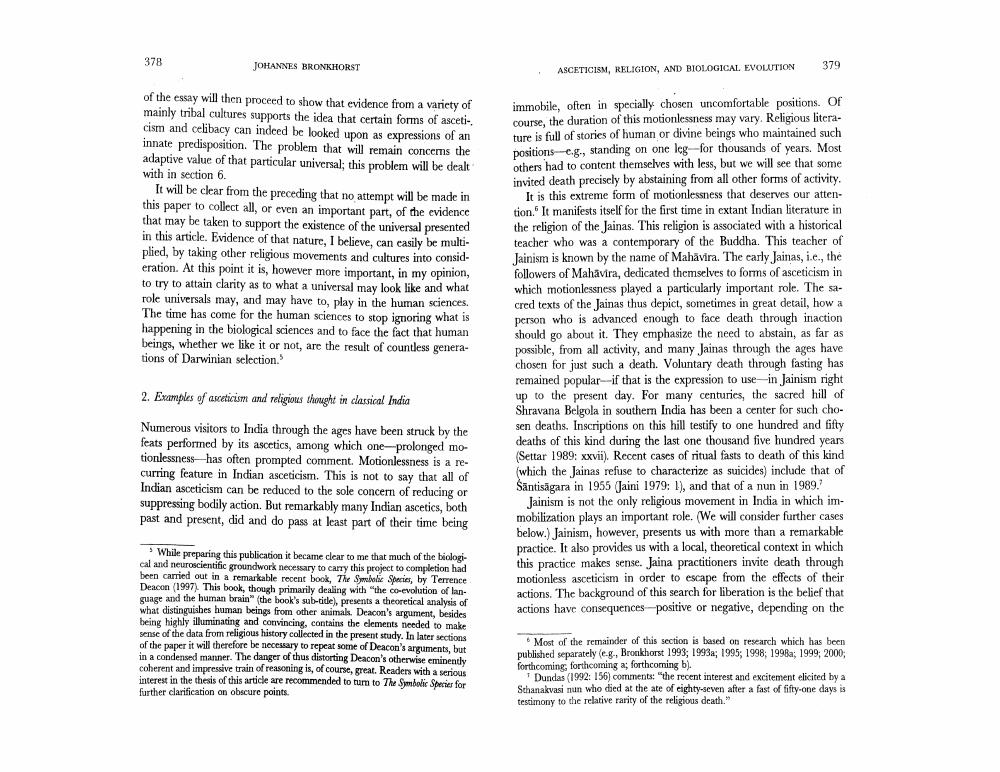Book Title: Asceticism Religion And Biological Evolution Author(s): Johannes Bronkhorst Publisher: Johannes Bronkhorst View full book textPage 3
________________ 378 JOHANNES BRONKHORST ASCETICISM, RELIGION, AND BIOLOGICAL EVOLUTION 379 of the essay will then proceed to show that evidence from a variety of mainly tribal cultures supports the idea that certain forms of asceticism and celibacy can indeed be looked upon as expressions of an innate predisposition. The problem that will remain concems the adaptive value of that particular universal; this problem will be dealt with in section 6. It will be clear from the preceding that no attempt will be made in this paper to collect all, or even an important part of the evidence that may be taken to support the existence of the universal presented in this article. Evidence of that nature, I believe, can easily be multiplied, by taking other religious movements and cultures into consideration. At this point it is, however more important, in my opinion, to try to attain clarity as to what a universal may look like and what role universals may, and may have to play in the human sciences. The time has come for the human sciences to stop ignoring what is happening in the biological sciences and to face the fact that human beings, whether we like it or not, are the result of countless genera. tions of Darwinian selection. immobile, often in specially chosen uncomfortable positions. Of course, the duration of this motionlessness may vary. Religious literature is full of stories of human or divine beings who maintained such positions-c.g., standing on one leg-for thousands of years. Most others had to content themselves with less, but we will see that some invited death precisely by abstaining from all other forms of activity, It is this extreme form of motionlessness that deserves our attention. It manifests itself for the first time in extant Indian literature in the religion of the Jainas. This religion is associated with a historical teacher who was a contemporary of the Buddha. This teacher of Jainism is known by the name of Mahavira. The carly Jainas, i.e., the followers of Mahavira, dedicated themselves to forms of asceticism in which motionlessness played a particularly important role. The sacred texts of the Jainas thus depict, sometimes in great detail, how a person who is advanced enough to face death through inaction should go about it. They emphasize the need to abstain, as far as possible, from all activity, and many Jainas through the ages have chosen for just such a death. Voluntary death through fasting has remained popular if that is the expression to use in Jainism right up to the present day. For many centuries, the sacred hill of Shravana Belgola in southern India has been a center for such chosen deaths. Inscriptions on this hill testify to one hundred and fifty deaths of this kind during the last one thousand five hundred years (Settar 1989: xxvii) Recent cases of ritual fasts to death of this kind (which the Jainas refuse to characterize as suicides) include that of Santisāgara in 1955 Jaini 1979: 1), and that of a nun in 1989. Jainism is not the only religious movement in India in which immobilization plays an important role. (We will consider further cases below.) Jainism, however, presents us with more than a remarkable practice. It also provides us with a local, theoretical context in which this practice makes sense. Jaina practitioners invite death through motionless asceticism in order to escape from the effects of their actions. The background of this search for liberation is the belief that actions have consequences positive or negative, depending on the 2. Examples of asceticism and religious thought in classical India Numerous visitors to India through the ages have been struck by the feats performed by its ascetics, among which one-prolonged motionlessness--has often prompted comment. Motionlessness is a recurring feature in Indian asceticism. This is not to say that all of Indian asceticism can be reduced to the sole concern of reducing or suppressing bodily action. But remarkably many Indian ascetics, both past and present, did and do pass at least part of their time being While preparing this publication it became clear to me that much of the biological and neuroscientific groundwork necessary to carry this project to completion had been carried out in a remarkable recent book, The Smal Sheries, by Terrence Deacon (1997). This book, though primarily dealing with the co-evolution of language and the human brain" the book's sub-side), presents a theoretical analysis of what distinguishes human beings from other animals. Deacon's argument, besides being highly illuminating and convincing, contains the elements needed to make sense of the data from religious history collected in the present study. In later sections of the paper it will therefore be necessary to repeat some of Deacon's arguments, but in a condensed manner. The danger of thus distorting Deacon's otherwise eminently coherent and impressive train of reasoning is, of course, great. Readers with a serious interest in the thesis of this article are recommended to tum to The Symbolic Sherier for further clarification on obscure points. elig and come other are pre Most of the remainder of this section is based on research which has been published separately (e.g., Bronkhorst 1993; 1993a; 1995; 19981998a; 1999, 2000; forthcoming forthcoming a; forthcoming b). Dundas 1992: 156) comments: the recent interest and excitement elicited by a Sthanakvasi nun who died at the ate of eighty-seven after a fast of fifty-one days is testimony to the relative rarity of the religious death."Page Navigation
1 2 3 4 5 6 7 8 9 10 11 12 13 14 15 16 17 18 19 20 21 22 23
